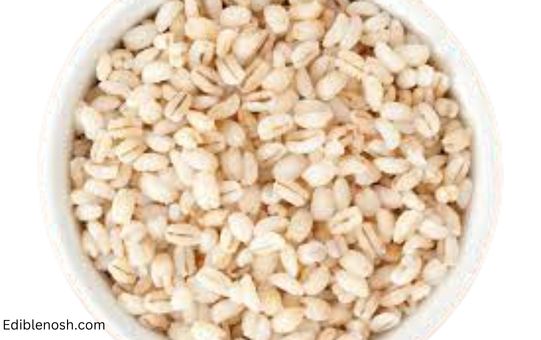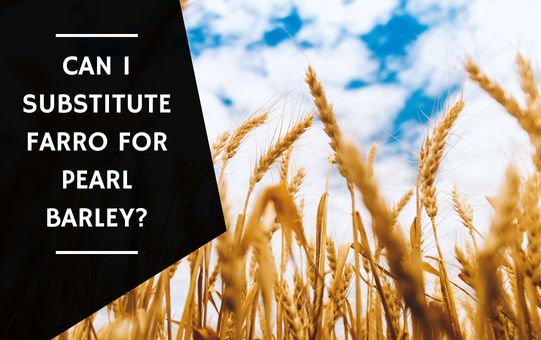If you enjoy cooking with grains, you may be wondering whether Farro can i substitute Farro for Pearl Barley.
Yes, you can substitute farro for pearl barley in some recipes; however, it is necessary to check and note the differences in cooking time, texture, flavor, and nutritional value before doing this switch. Farro has a chewier texture and a slightly sweet, nutty flavor, whereas pearl barley has a softer texture and a slightly nutty, neutral flavor. Before making a change, it’s always a good idea to do some research and see how other people have dealt with the same problem.
In this article, you will get to know the difference between farro and pearl barley, moreover, whether they can be used interchangeably in recipes. Read on to find out more!
Contents
What about Pearl Barley?
Pearl barley, on the other hand, is a type of barley that’s been polished to remove its outer husk and bran layers. This process gives pearl barley a more refined, softer texture than whole grain barley, which has a chewier, more rustic texture.
Pearl barley has a slightly nutty flavor and a creamy, slightly sticky consistency when cooked, which makes it a good choice for dishes like soups, stews, and casseroles. It’s also often used in dishes like pilafs and grain bowls.
Read Also: Can I Substitute Orzo for Farro?
How Can I Substitute Farro for Pearl Barley (or Vice Versa)?
It depends on the recipe. Here are a few things to consider when deciding whether or not to make the swap:
- Cooking Time:
Farro and pearl barley have slightly different cooking times, which can be a factor if you’re working with a recipe that calls for a specific cooking time. Farro tends to take longer to cook than pearl barley – usually about 20-30 minutes longer.
This means that if you’re using farro in a recipe that calls for pearl barley, you might need to adjust the cooking time accordingly.
On the other hand, if you’re using pearl barley in a recipe that calls for farro, you might need to reduce the cooking time a bit to avoid overloading the dish.

- Texture:
Farro and pearl barley have slightly different textures, which can affect the final result of your dish. Farro has a chewier, more toothsome texture than pearl barley, which can make it a better choice for dishes where you want a bit of texture (like grain bowls or salads).
Pearl barley, on the other hand, has a softer, more creamy texture that works well in dishes where you want a smoother consistency (like soups or stews). If you’re using farro in a recipe that calls for pearl barley, you might want to consider whether the chewier texture will be a good fit for the dish.
Similarly, if you’re using pearl barley in a recipe that calls for farro, you’ll want to think about whether the softer texture will be suitable for the dish.
- Flavor:
Farro and pearl barley have slightly different flavors, which can also be a factor when deciding whether or not to make the swap. Farro has a nutty, slightly sweet flavor that works well in dishes with bold, savory flavors (like soups or grain bowls with lots of herbs and spices).
Pearl barley, on the other hand, has a slightly nutty flavor that’s more subtle and neutral, making it a good choice for dishes where you want the other ingredients to be the star (like stews or casseroles).
If you’re using farro in a recipe that calls for pearl barley, you might want to consider whether the slightly sweet flavor will be a good fit for the dish.
Similarly, if you’re using pearl barley in a recipe that calls for farro, you’ll want to think about whether the more neutral flavor will be suitable for the dish.
- Nutritional Value:
Farro and pearl barley are both nutritious grains, but they have slightly different nutritional profiles. Farro is a good source of fiber, protein, and nutrients like iron, zinc, and B vitamins. It’s also relatively low in calories and has a low glycemic index, which means it can be a good choice for people who are trying to manage their blood sugar levels.
Pearl barley is also a good source of fiber, protein, and nutrients like iron, zinc, and B vitamins. However, it has a slightly higher calorie and carbohydrate content than farro, and its glycemic index is slightly higher as well.
If you’re using farro in a recipe that calls for pearl barley, you might want to consider whether the slightly lower calorie and carbohydrate content will be a good fit for your dietary needs.
Similarly, if you’re using pearl barley in a recipe that calls for farro, you’ll want to think about whether the slightly higher calorie and carbohydrate content will be suitable for your dietary needs.
Read Also: Can I Substitute Farro For Barley In Soup?
Final Thought
While it’s possible to substitute farro for pearl barley (or vice versa) in some recipes, it’s important to consider the differences in cooking time, texture, flavor, and nutritional value before making the swap.
If you’re trying to decide whether to use farro or pearl barley in a particular recipe, it’s always a good idea to do a bit of research and see how others have made the substitution before diving in.
With a bit of experimentation and a little bit of trial and error, you should be able to find the grain that works best for your recipe and your taste preferences.
FAQs | Substitute Farro for Pearl Barley
Here are five relevant FAQs for the topic of Can I Substitute Farro for Pearl Barley?:
What Is Farro, And What Is Pearl Barley?
Farro is a type of grain that’s native to the Middle East and made from three varieties of wheat: einkorn, emmer, and spelt. It has a nutty, slightly sweet flavor and a chewy texture.
Pearl barley is a type of barley that’s been polished to remove its outer husk and bran layers, giving it a more refined, softer texture than whole-grain barley. It has a slightly nutty flavor and a creamy, slightly sticky consistency when cooked.
Can I Use Farro In A Recipe That Calls For Pearl Barley, Or Vice Versa?
It’s possible to substitute farro for pearl barley (or vice versa) in some recipes, but it’s important to consider the differences in cooking time, texture, flavor, and nutritional value before making the swap.
Farro has a chewier texture and a nutty, slightly sweet flavor, while pearl barley has a softer texture and a slightly nutty, more neutral flavor. You may need to adjust the cooking time or the number of other ingredients in the recipe to accommodate the different grains.
What Are The Differences Between Farro And Pearl Barley In Terms Of Cooking Time?
Farro tends to take longer to cook than pearl barley – usually about 20-30 minutes longer. This means that if you’re using farro in a recipe that calls for pearl barley, you might need to adjust the cooking time accordingly.
On the other hand, if you’re using pearl barley in a recipe that calls for farro, you might need to reduce the cooking time a bit to avoid overloading the dish.
What Are The Differences Between Farro And Pearl Barley In Terms Of Texture?
Farro has a chewier, more toothsome texture than pearl barley, which can make it a better choice for dishes where you want a bit of texture (like grain bowls or salads).
Pearl barley, on the other hand, has a softer, more creamy texture that works well in dishes where you want a smoother consistency (like soups or stews).
What Are The Differences Between Farro And Pearl Barley In Terms Of Flavor?
Farro has a nutty, slightly sweet flavor that works well in dishes with bold, savory flavors (like soups or grain bowls with lots of herbs and spices).
Pearl barley has a slightly nutty flavor that’s more subtle and neutral, making it a good choice for dishes where you want the other ingredients to be the star (like stews or casseroles).

